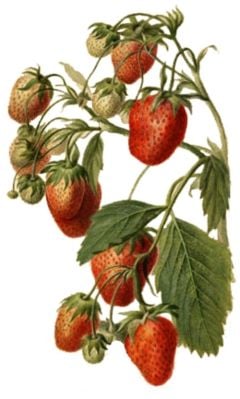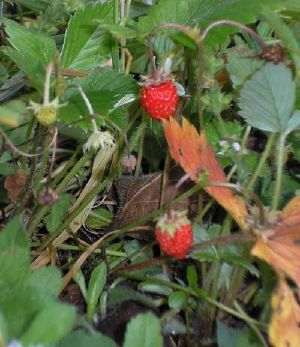Difference between revisions of "Strawberry" - New World Encyclopedia
Rick Swarts (talk | contribs) |
Rick Swarts (talk | contribs) |
||
| Line 18: | Line 18: | ||
''20+ species; see text'' | ''20+ species; see text'' | ||
}} | }} | ||
| − | '''Strawberry''' is any of the various, low-growing perennial plants of the [[genus]] ''Fragaria'' in the rose family ([[Rosaceae]]''), as well as the name for the red, aggregate fruit of this plant. There are more than 20 named [[species]] and many hybrids and [[cultivar]]s. The most common strawberries grown commercially are cultivars of the [[ | + | '''Strawberry''' is any of the various, low-growing perennial plants of the [[genus]] '''''Fragaria''''' in the rose family ([[Rosaceae]]''), as well as the name for the red, edible, aggregate [[fruit]] of this plant. There are more than 20 named [[species]] and many hybrids and [[cultivar]]s. The most common strawberries grown commercially are cultivars of the [[garden strawberry]], ''Fragaria'' × ''ananassa''. |
==Description== | ==Description== | ||
| − | The strawberry is an [[accessory fruit]]; that is, the fleshy part is derived not from the ovaries which | + | |
| + | ''Fragaria'' is a [[genus]] of [[plant]] in the family [[Rosaceae]]. Rosaceae is one of the largest families of [[flowering plant]]s with about 3,400 species, including [[apple]]s, berries, [[peach]]es, [[plum]]s, cherries, the hawthorn tree, the mountain ash, and many others. | ||
| + | |||
| + | ''Fragaria'' are low herbaceous perennial plants that have compound [[leaf|leaves]] with three hairy, sawtooth edged leaflets. The [[flower]]s are white and grow in clusters on thin stalks. In addition to the seeds produced by these flowering plants, strawberries spread by stolons as they get older. | ||
| + | |||
| + | The fleshy, edible strawberry "fruit" is technically not a single fruit nor a berry. It is an [[accessory fruit]]; that is, the fleshy part is derived not from the ovaries, which yield the "seeds" (actually [[achene]]s), but from the peg at the bottom of the [[hypanthium]] that held the ovaries. (The hypanthium is the bowl-shaped part of a flower consisting of the bottoms of the sepals, petals, and stamens stuck together). So from a technical standpoint, the seeds are the actual fruits of the plant, and the flesh of the strawberry is modified receptacle [[tissue]], which contains numerous partially embedded fruits (seeds). It is whitish-green as it develops and in most species turns red when ripe. | ||
==History== | ==History== | ||
Revision as of 19:40, 20 July 2007
| Strawberry | ||||||||||||||
|---|---|---|---|---|---|---|---|---|---|---|---|---|---|---|
 | ||||||||||||||
| Scientific classification | ||||||||||||||
| ||||||||||||||
|
20+ species; see text |
Strawberry is any of the various, low-growing perennial plants of the genus Fragaria in the rose family (Rosaceae), as well as the name for the red, edible, aggregate fruit of this plant. There are more than 20 named species and many hybrids and cultivars. The most common strawberries grown commercially are cultivars of the garden strawberry, Fragaria × ananassa.
Description
Fragaria is a genus of plant in the family Rosaceae. Rosaceae is one of the largest families of flowering plants with about 3,400 species, including apples, berries, peaches, plums, cherries, the hawthorn tree, the mountain ash, and many others.
Fragaria are low herbaceous perennial plants that have compound leaves with three hairy, sawtooth edged leaflets. The flowers are white and grow in clusters on thin stalks. In addition to the seeds produced by these flowering plants, strawberries spread by stolons as they get older.
The fleshy, edible strawberry "fruit" is technically not a single fruit nor a berry. It is an accessory fruit; that is, the fleshy part is derived not from the ovaries, which yield the "seeds" (actually achenes), but from the peg at the bottom of the hypanthium that held the ovaries. (The hypanthium is the bowl-shaped part of a flower consisting of the bottoms of the sepals, petals, and stamens stuck together). So from a technical standpoint, the seeds are the actual fruits of the plant, and the flesh of the strawberry is modified receptacle tissue, which contains numerous partially embedded fruits (seeds). It is whitish-green as it develops and in most species turns red when ripe.
History
The typical modern strawberry, of the genus Fragaria, comes from the Americas, and is a hybrid of both North and South American varieties. Ironically, the crossbreeding was done in Europe to correct a mistake; the European horticulturists had only brought female South American plants, and were forced to cross them with the North American variety in order to get fruit and seeds.
Fragaria comes from "fragans", meaning odorous, referring to the perfumed flesh of the fruit. Madam Tallien, a great figure of the French Revolution, who was nicknamed Our Lady of Thermidor, used to take baths full of strawberries to keep the full radiance of her skin. Fontenelle, centenarian writer and gourmet of the 18th century, considered his long life was due to the strawberries he used to eat. Strawberries were considered poisonous in Argentina until the mid-nineteenth century.[citation needed]
Classification
There are more than 20 different Fragaria species worldwide. Key to the classification of strawberry species is recognizing that they vary in the number of chromosomes. There are seven basic types of chromosomes that they all have in common. However, they exhibit different polyploidy. Some species are diploid, having two sets of the seven chromosomes (14 chromosomes total). Others are tetraploid (four sets, 28 chromosomes total), hexaploid (six sets, 42 chromosomes total), octoploid (eight sets, 56 chromosomes total), or decaploid (ten sets, 70 chromosomes total).
As a rough rule (with exceptions), strawberry species with more chromosomes tend to be more robust and produce larger plants with larger berries (Darrow).
- Diploid species
- Fragaria daltoniana
- Fragaria iinumae
- Fragaria nilgerrensis
- Fragaria nipponica
- Fragaria nubicola
- Fragaria vesca (Woodland Strawberry)
- Fragaria viridis
- Fragaria yezoensis
- Tetraploid species
- Fragaria moupinensis
- Fragaria orientalis
- Hexaploid species
- Fragaria moschata (Musk Strawberry)
- Octoploid species and hybrids
- Fragaria x ananassa (Garden Strawberry)
- Fragaria chiloensis (Beach Strawberry)
- Fragaria iturupensis (Iturup Strawberry)
- Fragaria virginiana (Virginia Strawberry)
- Decaploid species and hybrids
- Fragaria × Potentilla hybrids
- Fragaria × vescana
Numerous other species have been proposed. Some are now recognized as subspecies of one of the above species (see GRIN taxonomy database).
The Mock Strawberry and Barren Strawberry, which both bear resemblance to Fragaria, are closely related species in the genus Potentilla. The Strawberry tree is an unrelated species.
Production trends
FAO reports that USA was the top producer of strawberry worldwide in 2005 followed by Spain.
Pests
A number of species of Lepidoptera feed on strawberry plants; for details see this list.
Diseases
Etymology
The name is derived from Old English strēawberiġe which is a compound of streaw meaning "straw" and berige meaning "berry". The reason for this is unclear. It may derive from the strawlike appearance of the runners, or from an obsolete denotation of straw, meaning "chaff", referring to the scattered appearance of the achenes.
Interestingly, in other Germanic countries there is a tradition of collecting wild strawberries by threading them on straws. In those countries people find straw-berry to be an easy word to learn considering their association with straws.[citation needed] (In fact, in almost all other Germanic languages besides English, the name of the fruit corresponds to "Earth-Berry", so this claim is dubious.)
There is an alternative theory that the name derives from the Anglo-Saxon verb for "strew" (meaning to spread around) which was streabergen (Strea means "strew" and Bergen means "berry" or "fruit") and thence to streberie, straiberie, strauberie, straubery, strauberry, and finally, "strawberry", the word which we use today. The name might have come from the fact that the fruit and various runners appear "strewn" along the ground.
Popular etymology has it that it comes from gardeners' practice of mulching strawberries with straw to protect the fruits from rot (a pseudoetymology that can be found in non-linguistic sources such as the Old Farmer's Almanac 2005). However, there is no evidence that the Anglo-Saxons ever grew strawberries, and even less that they knew of this practice.
Gallery
Strawberry farm in DaHu, Taiwan
Green strawberry late May 2007 Seattle, Washington
Trivia
See also
- Garden Strawberry
- Epigynous berry
References and external links
- Darrow, George M. The Strawberry: History, Breeding and Physiology. New York. Holt, Rinehart and Winston, 1966.
- Available online.
- [1]Straberry in Cameron Highlands
- List of Fragaria resources, USDA
- GRIN Fragaria Taxonomy Database Listing of Fragaria species, also from a USDA website
- Medicinal uses of strawberries in Armenia
- Fragaria chiloensis pictures from Chilebosque
- A wikimanual of Gardening: Strawberry
- Strawberry pest management guidelines
- Crossing of cv. 'Mieze Schindler' with cv. 'Elsanta'
- Herbst, S. T. 2001. The New Food Lover's Companion: Comprehensive Definitions of Nearly 6,000 Food, Drink, and Culinary Terms. Barron's Cooking Guide. Hauppauge, NY: Barron's Educational Series. ISBN 0764112589
Credits
New World Encyclopedia writers and editors rewrote and completed the Wikipedia article in accordance with New World Encyclopedia standards. This article abides by terms of the Creative Commons CC-by-sa 3.0 License (CC-by-sa), which may be used and disseminated with proper attribution. Credit is due under the terms of this license that can reference both the New World Encyclopedia contributors and the selfless volunteer contributors of the Wikimedia Foundation. To cite this article click here for a list of acceptable citing formats.The history of earlier contributions by wikipedians is accessible to researchers here:
The history of this article since it was imported to New World Encyclopedia:
Note: Some restrictions may apply to use of individual images which are separately licensed.











